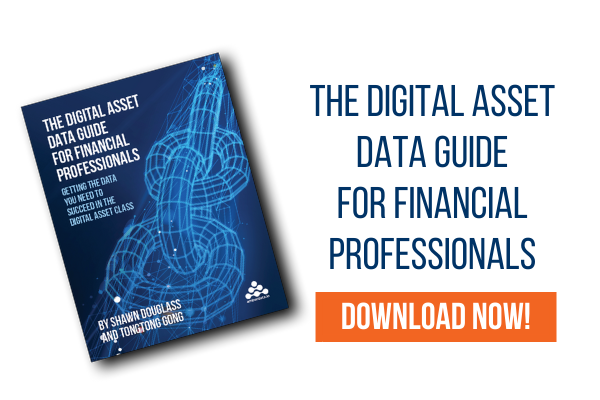
Digital assets trade in spot markets, derivatives markets, and on decentralized trading venues across the world and around the clock. Comprehensive, granular data is needed to participate in digital assets, just as it is with traditional asset classes. It’s the only way to understand the markets, volatility, liquidity, and fundamentals so you know how to operate, as well as stay compliant and competitive.
However, collecting the necessary information is challenging due to the decentralized, globalized, and round-the-clock nature of the digital asset ecosystem.
The two types of digital asset data
To get a complete view of the cryptoeconomy, you need both market data and fundamental (on-chain) data. Market data is sourced from centralized exchanges like Coinbase and Binance, while fundamental data is collected directly from the various blockchains. Financial Institutions entering the digital asset class need comprehensive sets of both data types to support pre- and post-trade activities.
Market data
Each centralized exchange has its own market data APIs. Getting statistics from each exchange requires building and maintaining a dedicated infrastructure to collect, ingest, store and serve the data in a highly available and scalable service institutions can depend on.
To enable real-time decision-making, you’ll need streaming Level I and Level II price data, while real-time and historical reference data will be needed for trading and compliance needs. Our historical asset price data stretches back as far as 2011 for some exchanges. You’ll also want to access VWAP and TWAP on and across exchanges, as well as OHLCV. To get visibility into spreads and potential slippage, you’ll need Best Bid and Best Offer (BBO) data.
You'll want to get visibility into global price discovery and market depth on all major spot and derivative exchanges. And you'll need to cover thousands of digital asset pairs and all the exchanges that matter to you, so your investors, traders and liquidity providers can rely on the information to develop strategies and meet regulatory obligations.
Low-latency access to real-time and historical market microstructure data from across the digital asset ecosystem is needed so you can effectively train models, discover, and manage risk, or even select the most appropriate venues to trade on. Make sure you get access to Tick-by-tick order book events and one minute order book snapshots.
Fundamental (on-chain) data
to gaining visibility into DEX transactions and DeFi activities. Without it, developing DeFi strategies, managing risk, and maintaining regulatory compliance is impossible.
Accessing on-chain metrics for digital assets requires building and maintaining highly available nodes for each blockchain you plan to work with. Each blockchain has its own specific requirements, including the technology used, procedures, protocols, and metrics. Each one also has its own security risks. Your team will need an expert for each blockchain you wish to work with to support its node(s).
Before it can be used, the raw blockchain data you collect needs to be processed to create actionable information. For making investment decisions, these data sets need to be comprehensive, granular, objective, and unfiltered. For institutional activities, it is also necessary to extract multiple types of information from the raw blockchain data to have the right context for each activity.
Adding to the challenge is the fact that not all information gets recorded to the blockchain permanently. This makes it impossible to replay exactly what happened on-chain unless the data is captured in flight. To capture this ephemeral data, financial institutions need to actively and reliably track blockchain activity 24/7.
You'll need to have metrics for transactions, contracts, events, and logs for each blockchain to enable analysis of the smart contract mechanisms that power cryptoeconomics—in real-time and historically. You'll need access to on-chain events and data for every token combined with Level I and Level II market data across the exchanges you care about so you can develop operational intelligence. You’ll also want the full historical activity for all accounts for accounting, tax, and compliance purposes.
Make sure you have access to blockchain streams including validation data, so you can build scalable applications on top of on-chain metrics. You’ll need deep insight into the state and health of the networks, assets, and activity such as hashrate, issuance, miner activity, fees, supply, asset, and address activity. You’ll also want key indicators like NVT, asset adoption, uniques, risk-adjusted returns, volatility, and asset velocity to help inform your decision making. You’ll need access to data for filtering and ranking digital assets and to develop valuation models like stock-to-flow to gain context.
Why DIY data infrastructure approaches are a non-starter
The open-source nature of digital assets makes it theoretically possible for anyone to build their own digital asset data infrastructure. However, the large number of data sources, the lack of standardization among those sources, and the complexity of processing blockchain data, make building and maintaining this infrastructure a major undertaking that requires significant investments in talent and technology.
If you were to build this infrastructure on your own, you'd need to recruit a team of experienced technology professionals from a limited talent pool that includes specialized blockchain developers and data infrastructure management experts, implement and support numerous blockchain nodes and exchange connections with 24/7 reliability, and process and integrate large amounts of inputs collected from multiple sources into actionable information usable by your teams. This process would take months or even years and cost millions of dollars.
Entering the data infrastructure business would be a significant distraction from a financial institution’s core business of providing financial services and products. A better approach is to work with a data provider that already has the necessary talent and infrastructure in place to collect and process digital asset data, providing a single integration point that eliminates the challenge of aggregating data from numerous disparate sources into actionable information to inform decision making.
Why Amberdata?
Amberdata is the alternative for financial institutions that want to avoid taking on a massive data infrastructure project to enter the digital asset class.
Our data infrastructure is built on an ultra-reliable and scalable foundation that allows you to build and grow your digital asset businesses with confidence. With our unified API and data services, you get datasets that are indexed, searchable and normalized to time series, providing a comprehensive view across the entire crypto-economy through a single integration point, allowing for an accelerated time to market for your digital asset offerings.
With years of blockchain and market data experience, Amberdata has been chosen as the trusted provider for many large financial institutions that have entered the digital asset class.
Amberdata
Amberdata is the leading provider of global financial infrastructure for digital assets. Our institutional-grade solutions deliver data, analytics and comprehensive tools and insights that empower financial institutions to research, trade, and manage risk and compliance in digital assets. Amberdata serves as a...
